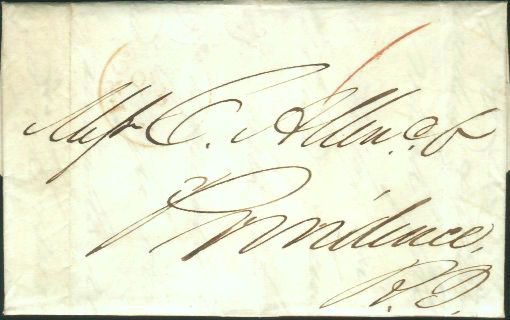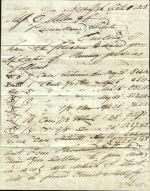![]()
Postal History Introduction
Stampless
Covers
1846
to 1900 Issues
1901-1950
Issues
1951-2003
Issues
Cancels
&
Miscellaneous
Postal
Stationery
Post
Cards
Air
Mail
First
Day &
Event Covers
Parcel Post/Special Delivery
Registered & Official Mail
Commercial & Advertising
Revenue & Postage Due
Wildlife & Game Issues
Complete List of RI Issues
|
Rhode Island Stampless
Covers & Letters |
||
|
||
|
This business letter was sent from
William Allen at Rd "3" New York on October 1, 1838 to
B. Allen and Co. Providence, Rhode Island and
concerns the sale of the company's goods and the prices realized
for them, (A Grand Total of $4209.38). The listed items are
different types of laundry supplies. The letter is one folded
sheet with two pages and begins as follows: New York Oct 1, 1838 Msrs B. Allen & Co.
Enclosed I have the pleasure to show you the sales of Laundry
goods as follows: |
|
|
DROP LETTERS Drop Letters are those letters that were dropped off at a Post Office for the Addressee to pick up at the same Post Office. In the 18th and 19th centuries, everyone had to pick up their mail at the post office unless it was delivered by a private courier. Drop letters were never sent from one Post Office to another and they were sometimes referred to as Box Letters. (The system was similar to General Delivery.) The Postal Act of 1794 set the rate for Drop Letters at 1 cent per letter. There was no additional fee by weight or number of sheets. The 1 cent charge was a Fee paid directly to the Postmaster, rather than a rate charge. Drop letters were sent either prepaid or collect until February 1861 when the Postal act of that year required that they be prepaid. Postal markings on Drop Letters are often lacking or incomplete, since they were delivered and picked up at the same Post Office; it wasn't felt necessary to apply all of the postal marks and cancellations to insure proper delivery. The customer or recipient of the Drop Letter would go to the counter at the Post Office, give the clerk his personal information and the clerk would sort through the alphabetically filed letters to find the correct letter. Between 1845 and 1851 the Drop Rate was increased to 2 cents, but was reduced to 1 cent again on July 1, 1851. During the 50 percent rate increase of 1816, drop letters should not have been affected as they were a fee and not a rate, however a total of 9 Drop Letters have been found with the 1 1/2 rate applied. |
||

RI Historical
Society
Introduction
Stampless I
Stampless II
Stampless III
Stampless IV
Stampless V
Stampless VI
Brown & Ives Letters
The Hazard Family Letters
Joseph Tillinghast
Free Franked Letters
DeWolf Family Letters
Recently Added Pages

